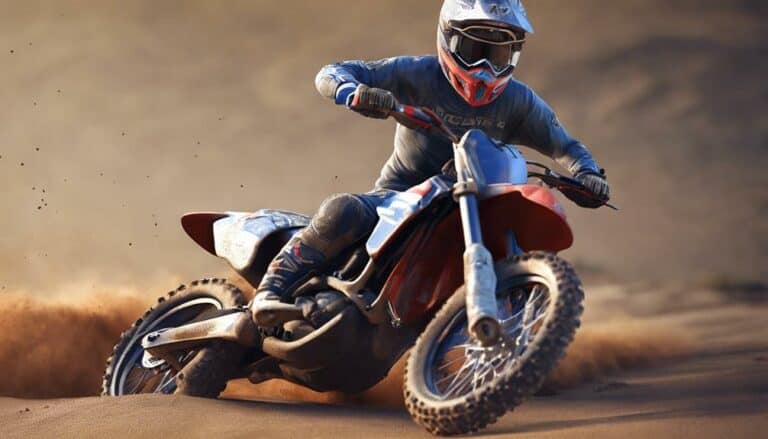Did you know that over 70% of off-road riding performance is directly impacted by proper body positioning? By mastering key techniques such as maintaining a balanced stance, precise foot and hand placement, and looking ahead to anticipate obstacles, you can greatly elevate your off-road riding skills.
But what specific tips can help you achieve this level of mastery for best performance on challenging terrains? Let's explore some practical strategies that can take your off-road riding to the next level and enhance your overall experience on the trail.
Key Takeaways
- Maintain a balanced stance with bent knees for control and stability.
- Ensure precise foot and hand placement to navigate rough terrains effectively.
- Look ahead to anticipate obstacles and adjust riding technique proactively.
- Practice advanced techniques like weight shifting and leaning for optimal off-road performance.
Importance of Proper Body Positioning
Enhancing your off-road performance begins with mastering the importance of proper body positioning. When riding off-road, your body becomes the key to opening control, stability, and balance.
Keeping your head up and shoulders relaxed not only enhances your view of the terrain but also allows for better weight distribution. By standing on the footpegs with bent knees, you're able to absorb impacts and increase stability, making it easier to navigate through rough trails.
Proper weight distribution plays a critical role in maintaining control and maneuverability. Make sure that your weight is evenly distributed on both feet and relax your grip on the handlebars to allow for smoother handling. Sitting closer to the gas tank while maintaining a relaxed posture will enhance your overall off-road riding experience.
Foundation: Ideal Riding Stance
Mastering the foundation of an ideal riding stance is pivotal for accessing peak off-road performance. When you're on your bike, standing on the footpegs with slightly bent knees is essential for absorbing impacts and maintaining stability over rough terrain.
Make sure your body weight is evenly distributed on both feet to enhance balance and control. Keep a relaxed grip on the handlebars to allow for better maneuvering and reduced fatigue during long rides.
Sitting closer to the gas tank not only improves control but also helps in weight distribution, contributing to overall stability. Remember to maintain a straight back, relaxed shoulders, and keep your head up to optimize weight distribution on the bike and enhance balance.
Mastering Foot and Hand Placement
Positioning your feet and hands correctly is essential for maximizing control and stability when riding off-road. To start, place your feet on the footpegs with your heels dropped for increased stability, especially in rough terrain. Keep your toes pointed slightly inward to avoid slipping off the footpegs during aggressive riding, ensuring a secure grip.
When it comes to hand placement, maintain a firm grip on the handlebars with your fingers covering the levers for quick access when needed.
To enhance steering control, position your hands at a comfortable width on the handlebars, allowing for precise movements and better overall stability. Remember not to grip the handlebars too tightly to prevent arm fatigue and maintain responsiveness to the terrain.
This balance between foot positioning and hand placement is essential for achieving aggressive riding stability and control off-road. By mastering your foot and hand placement, you set yourself up for a smoother, more controlled riding experience, enhancing both performance and comfort on the trails.
Looking Ahead for Anticipation
As you navigate through rugged off-road terrain, your success hinges on the ability to anticipate what lies ahead with a forward gaze that guides your path and actions. Looking ahead allows you to anticipate obstacles, adjust your riding technique, and plan your line choice accordingly. By maintaining a forward gaze, you can react proactively to changes in the trail, ensuring that you stay in control of your bike at all times. This proactive approach not only helps you navigate obstacles smoothly but also enhances your riding flow.
Developing the habit of consistently looking ahead is essential for building confidence and improving your performance on off-road trails. By focusing on the path ahead, you reduce the need for last-minute reactions, enabling you to maintain a steady and controlled ride. Embrace the liberation that comes with anticipating what's to come, and watch as your off-road skills soar to new heights.
Advanced Techniques for Better Performance
To elevate your off-road riding skills to the next level, incorporate advanced techniques for better performance. Master the art of lean techniques to optimize tire traction and control, allowing you to maneuver through challenging terrain with confidence.
Use your legs and arms as shock absorbers to absorb impacts and maintain stability, enhancing your ability to handle rough off-road conditions. Vital weight shifting is essential for precise braking and acceleration control, especially when faced with obstacles or sudden terrain changes.
Lean slightly forward during acceleration to improve traction and overall performance off-road. Practice advanced body positioning maneuvers to navigate through obstacles seamlessly, ensuring you maintain control and stability throughout your ride.
Conclusion
To wrap up, remember this: 'Smooth seas don't make skillful sailors.'
By mastering proper body positioning techniques, you can navigate rough terrains with confidence and control. Keep your head up, back straight, and shoulders relaxed.
Practice standing on footpegs, balancing your weight, and looking ahead to anticipate obstacles.
With dedication and practice, you'll become a skilled rider capable of conquering any off-road challenge that comes your way.
Ride on, adventurer!

